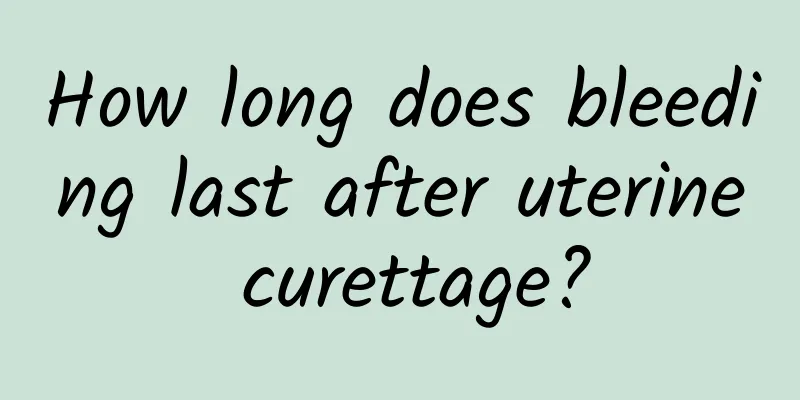How long does bleeding last after uterine curettage?

|
Usually, bleeding symptoms will occur after a uterine curettage. This is normal and patients do not need to worry too much. As long as they keep their emotions stable and do not fluctuate too much, serious situations will not occur. Most patients will have vaginal bleeding for about a week. If it lasts longer, relevant treatment can only be carried out. This may be caused by pathological reasons. Curettage and dilation is a procedure to scrape out the endometrium or uterine cavity contents. This is a minor surgery commonly performed in obstetrics and gynecology and is one of the methods of artificial abortion. It is divided into two categories: diagnostic curettage (abbreviated as DCT) and therapeutic curettage. There are certain risks and complications. ① Diagnostic curettage is divided into general diagnostic curettage and segmented diagnostic curettage. General diagnostic curettage is suitable for endocrine abnormalities, which require understanding of endometrial changes and responses to sex hormones, the presence or absence of ovulation, the presence or absence of tuberculosis, etc. Segmented diagnostic curettage refers to the operation of first scraping the cervical canal and then the uterine cavity. The scrapings are sent for pathological examination separately. It is suitable for diagnosing cervical cancer, endometrial cancer and other uterine malignancies, and can understand the scope of cancer. ②Therapeutic curettage can be divided into suction curettage and forceps curettage. Suction curettage is the use of a negative pressure suction tube to suck out the contents of the uterine cavity, while forceps curettage is the use of an oval forceps to remove the contents of the uterine cavity, followed by curettage. The indications for therapeutic curettage include: those who want to terminate the pregnancy in early pregnancy, suction curettage within 3 months of pregnancy, forceps curettage to remove residual materials in the uterine cavity after 3 months and after induced abortion; those who need to empty the uterine cavity for incomplete abortion, inevitable abortion, missed abortion, retained placenta, hydatidiform mole, etc. Contraindications include acute genital tract and pelvic inflammation, trichomoniasis and candidal vaginitis, and patients with severe medical diseases who cannot tolerate surgery. Note: Understand the indications and choose the appropriate time and procedure for different diseases. The doctor must be skilled in the technique to avoid various unnecessary complications, such as uterine perforation, heavy bleeding, incomplete curettage, postoperative uterine adhesions, infection, etc. Due to trauma to the endometrium after curettage, there will be vaginal bleeding within two weeks after the operation. Generally, the amount of blood is less than or similar to the menstrual amount, which is normal. If the bleeding has not stopped for more than two weeks or the amount of blood exceeds the menstrual volume, please go to the hospital immediately. |
<<: What causes cervical bleeding?
>>: What to do if your teeth bleed when you brush them
Recommend
Is egg retrieval painful or angiography painful?
The reproductive technology of in vitro fertiliza...
What happens if brain tinnitus is not treated for a long time?
The normal function of the ear is to receive soun...
Five methods of treating tinnitus by an old Chinese doctor: holding your breath and pressing your ears
Based on years of experience in preventing and tr...
Why Western medicine has not been able to conquer cancer so far
Why can't Western medicine conquer cancer so ...
Treatment for right tonsil enlargement
Tonsils are a kind of lymphatic organ in the huma...
What to do if the arm is scratched
In daily life, we often get some abrasions acciden...
How much American ginseng should be soaked in water?
Korean ginseng is a Chinese medicinal material th...
What diseases can colonoscopy detect?
Colonoscopy is a common method of examination. It...
What should not be taken with Maca?
Since maca is a traditional Chinese medicine, the...
10 Chinese herbal medicines to help you protect your skin against aging
What women fear most is the aging of their skin. ...
What to do if you have drool rash? Try these methods
Drool rash is a skin disease that makes people fe...
Pain where the jaw meets the neck
The junction of the chin and neck can be said to ...
How to treat femoral head necrosis
Generally in the early stages, how to treat femor...
What is the relationship between exercise and sleep at night?
People have busy work during the day and cannot s...
Can an umbilical hernia in a baby heal on its own?
Umbilical hernia in infants is relatively common ...









